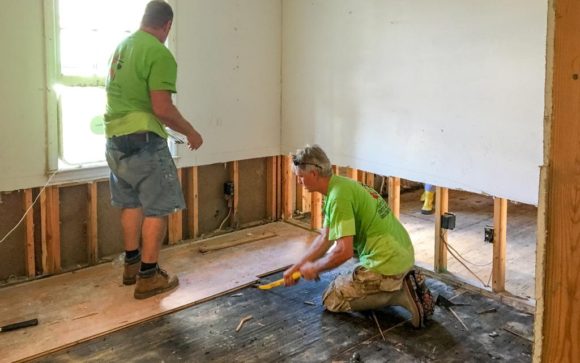In the storm-weary Carolinas, Hurricane Michael is stoking fresh fears among homeowners who still have tarps on their roofs or industrial dehumidifiers drying their floors from destruction left by Hurricane Florence.

Thousands of homes in North and South Carolina were damaged when the September hurricane smashed trees into rooftops and pushed floodwater into living rooms. Both states are still tallying damage, and homeowners are just starting to tear out moldy carpets, toss ruined furniture and negotiate with insurance adjusters. They fear delays or further damage from the new storm, which is expected to start lashing the Carolinas on Wednesday as it moves inland.
While the Carolinas won’t get a direct hit from Michael, even a weak storm could bring strong winds and inches of rain.
“It absolutely is a concern for me, as my house is still tarped,” said Shane Fernando, 38, who lives near downtown Wilmington where trees toppled by Florence blocked roads and fell into houses – including his. “Of course that makes me anxious.”
North Carolina Gov. Roy Cooper warned that Michael is expected to bring tropical-force winds and 2-5 inches (5-12.7 centimeters) of rain across much of the state. While the storm wasn’t expected to cause major river flooding like Florence, he urged people to stay vigilant.
“I know people are fatigued from Florence, but don’t let this storm catch you with your guard down,” Cooper said.
While the state hasn’t provided a detailed damage estimate, it’s clear Florence affected thousands of homes. More than 24,000 homeowners and renters have received FEMA housing assistance. Public schools in some hard-hit places remained closed, such as in coastal Pender County, where the school system announced Monday its schools would not reopen before Oct. 18.
“We also have repairs beginning in many homes. A number of homes have rooftop tarps that could be damaged or blown away with this wind,” Cooper said Tuesday.
In South Carolina, Gov. Henry McMaster estimated Florence’s damage would top $1 billion in a letter to the federal government. Earlier this month, the state said about 1,600 homes – and counting – were damaged, including 55 that were destroyed.
South Carolina emergency officials warned the state will have heavy rain, gusty winds, storm surge and possible tornadoes from Michael. And not everywhere has dried out from the last storm: The Waccamaw River remained out of its banks more than three weeks after Florence made landfall.
Forecasters don’t expect widespread Carolinas flooding, but warn Michael’s winds could be stronger than Florence’s.
“I wouldn’t expect massive amounts of flooding. It’s moving a lot faster. The rivers will go up briefly, but they shouldn’t come near the levels after Florence,” said National Weather Service meteorologist Carl Morgan.
Back in Wilmington, tarps cover Fernando’s roof and walls where a tree was blown over in his neighborhood a few miles from Florence’s landfall. He worries about new damage from Michael just as he’s dried residual moisture from the earlier storm.
“This is ironic, but we just finished the drying phase. We gutted the rooms that were affected and had industrial dehumidifiers to dry it out,” he said.
He’s been working with his homeowners’ insurance while paying for some work out of pocket with hopes of reimbursement: “That’s all still being worked out, little by little.”
In Pender County, Michael threatened to compound the woes for the Cross Creek neighborhood, where homeowners sustained flood and tree damage from Florence. Sarah Robles’ family has been staying at her father’s house after floodwater seeped into floors, mold grew on ceilings and the windows and roof were damaged.
“Trees went through people’s houses, and they didn’t even get a chance to repair them, and now there’s going to be more rain and wind that’s going to get back in people’s houses,” she said. “We’re fighting mold as it is.”
(Collins reported from Columbia, South Carolina.)
Was this article valuable?
Here are more articles you may enjoy.


 OpenAI And Microsoft Sued Over Murder-Suicide Blamed on ChatGPT
OpenAI And Microsoft Sued Over Murder-Suicide Blamed on ChatGPT  Truckers Who Fail English Tests Get Pulled Off Roads in Trump Crackdown
Truckers Who Fail English Tests Get Pulled Off Roads in Trump Crackdown  Tricolor Trustee Plans to Sue Founder for Auto Dealer’s Collapse
Tricolor Trustee Plans to Sue Founder for Auto Dealer’s Collapse  ‘Super Roofs’ Are Rewarding Insurers, Cat Bond Investors and Homeowners
‘Super Roofs’ Are Rewarding Insurers, Cat Bond Investors and Homeowners 